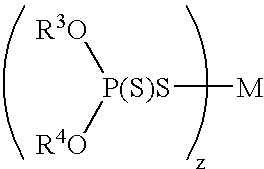Base oil blends for conveyor chain lubricating compositions
- Summary
- Abstract
- Description
- Claims
- Application Information
AI Technical Summary
Benefits of technology
Problems solved by technology
Method used
Image
Examples
examples
[0035] Table 1 compares the volatility a blend according to this disclosure to the volatility of the three starting oils. All of the oils include 2.5% Ba sulfonate (BSN-HT-PE2), 1.5% polysiloxane (DC 203 from Dow Corning), 1% tricresyl phosphate (Syn-o-add 8484), 0.1% ZDDP (Elco 102 from Elco Corp.), 0.1% ZDDC (Vanlube AZ from R. T. Vanderbilt), and 2% phenylamine (L-57 from Ciba Speciality Chemcials) based on the weight of the oil blend. The blend comprises Amoco Indopol H-300 polybutene (PIB) having a number average molecular weight of about 1330; a technical grade of polyol ester (POE) from pentaerythritol and a 70:30 wt ratio blend of normal C.sub.8 and normal C.sub.10 monocarboxylic acids; and a hydrotreated mineral oil Paraflex HT-100 from Petro-Canada (MO). The weight ratios of the components were 33 PIB, 37 POE, and 30 MO. The viscosities of the lubricants at 40.degree. C. using ASTM D-445 are giving in Table 1 below. The amount of volatiles lost by each lubricant is also gi...
PUM
 Login to View More
Login to View More Abstract
Description
Claims
Application Information
 Login to View More
Login to View More - R&D
- Intellectual Property
- Life Sciences
- Materials
- Tech Scout
- Unparalleled Data Quality
- Higher Quality Content
- 60% Fewer Hallucinations
Browse by: Latest US Patents, China's latest patents, Technical Efficacy Thesaurus, Application Domain, Technology Topic, Popular Technical Reports.
© 2025 PatSnap. All rights reserved.Legal|Privacy policy|Modern Slavery Act Transparency Statement|Sitemap|About US| Contact US: help@patsnap.com

